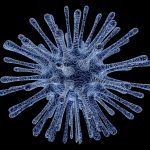The bacteriocins are peptides proteins that are toxic to microorganisms. They are produced by other bacteria and yeasts which are not lethal to themselves. They are ribosomally synthesized and produced by both Gram-positive and Gram-negative bacteria. They are increasingly being seen as a solid example of a postbiotic.
Like antibiotics, they are secondary metabolites produced during the stationary growth phase for a bacterial fermentation.
Food related examples include nisin.
The first bacteriocin called colicin was identified in 1925 from a fermentation of Escherichia coli.
There are 4 classes.
Class I – lantibiotics. These contain modified amino acids, are stable to heat and include elongated cationic peptides, spheric peptides, lasso peptides etc.
Class II – small heat labile and stable non-lantibiotics or unmodified peptides. Sub-divided into 4 subdivisions.
Class III – large heat labile proteins
Class IV – complex peptides with lipid and carbohydrate groups
The range of inhibitory activity by bacteriocins of various bacteria can be either narrow inhibiting only those strains that are closely related to the producer organism, or wide, inhibiting a diverse group of Gram-positive microorganisms.
Colicins and microcins are peptides produced by bacteria of the Enterobacteriaceae family. Bacteriocins kill other bacteria by inserting themselves into the bacteria membrane causing them to lose their ability to form pH gradients. These compounds this form pores and membrane channels which are uncontrolled. In some cases the bacteria to be treated to be damaged for the bacteriocin to function. This requires subjecting the bacteria to a sublethal stress before application of the bacteriocin.
Lactic acid bacteria are commonly fermented because LAB bacteriocins are very effective. This is part of a range of compounds including other metabolic end products (Klaenhammer, 1988).
Detection
Bacteriocins and other antimicrobials are detected using a variety of methods mainly based on agar plate technology and broth cultures.
Isolation
- Collect a food product which is fermented.
- Dilute appropriately
- Incubate aerobically on suitable agar
- Isolate the bacteriocin producing bacteria using pour plate methods
- Transfer the colonies to an MRS borth, collect the supernatant by centrifugation
- Precipitate and select for the bacteriocin.
To assay for bacteriocins, use ELIZA.
Class I
- nisin A (Lactoccocus lactis)
- Lacticin 3147 (L. lactis)
- cinnamycin (Streptomyces cinnamoneus)
- mersacidin (Bacillus spp.)
- sviceucin (Streptomyces sviceus).
Class II-a – Contain the conserved amino acid end YGNGV and inhibits Listeria.
- Pediocin CP2 (Pediococcus acidilacti)
Class II-b –
- Thuricin CD (Bacillus thuringiensis)
Class II-c an N-C terminal covalently bonded molecule forming a conserved cyclic peptide backbone.
- Gassericin A (Lactobacillus gasseri)
Class II-d – linear but not fully modified.
- Bactofencin A (Lactobacillus salivarus)
Class II – high molecular weight and thermally unstable
- colicin V (Escherichia coli)
The biochemical behaviour of bacteriocins are assessed for changes in the proton motive force (PMF) where they disrupt the membrane potential by collapsing the pH gradient. Sensitive cells rapidly die as a result. Other measures include the efflux of ATP, of ions. There can be measures of ultraviolet-absorbing materials and fluoresce-loaded phospholipid vesicles.
Application in Food Preservation
Biopreservatives are used to treat foods but only a few are suitable for this purpose. Gram-positive bacteria are inhibited by most bacteriocins. Gram-negative bacteria can be increasingly sensitive to bacteriocins after the use of chelating agents or hydrostatic pressure (Kalchayanand et al., 1992).
The food grade bacteriocins are nisin produced by Lactococcus lactis ssp. lactis and in use since 1959 (Fowler and Gasson, 1991). Applications have been made for pediocin from Pediococcus.
MicroGARD is an FDA approved commercial preparation from Danisco (skim milk fermentate of Propionibacterium freudenreichii subsp. Shermanii) used as an eminent bio-preservative in various dairy and food matrices
Meat preservation
Meat is notoriously perishable and prone to microbial contamination.
LAB bacteriocins are seen as natural effective preservatives for meat. Inoculation of bacteriocin-producing LAB cell as starter or protective culture is feasible for fermented meats such as fermented sausage.
Two bacteriocins GarQ (Garvicin Q) and Bac7293A, which are novel Class IId compounds have been isolated from Lactobacillus garvieae and incorporated into packaging (Woraprayote et al., 2016).
Packaging
Bacteriocins have been incorporated into packaging to wrap around meat for example.
Medical Applications
A notorious bacteria, Pseudomonas aeruginosa is not a food spoilage organism but also causes pneumonia in hospitalised and immuncompromised people. A bacteriocin from Pediococcus acidilactiti HW01 can effectively inhibit the creation of the biofilm that P. aeruginosa is able to generate as part of its virulent activity (Lee et al., 2020). The bacteriocin however unfortunately does not affect the viability of the planktonic form of the bacteria. It’s worth noting that virtually all the Pediococcus species are opportunistic pathogens themselves.
References
And, H. C., & Hoover, D. G. (2003). Bacteriocins and their food applications. Comprehensive Reviews in Food Science and Food Safety, 2(3), pp. 82-100.
Fowler, G.G. and Gasson, M.J. (1991) Antibiotics – nisin. InFood Preservatives ed. Russell, N.J. and Gould, G.W. pp. 135–152.Glasgow, UK: Blackie and Son Ltd.
Kalchayanand, N.; Hanlin, M.B.; Ray, B. (1992) Sublethal injury makes Gram-negative and resistant Gram-positive bacteria sensitive to the bacteriocins, pediocin AcH and nisin. Lett. Appl. Microbiol. 15, pp. 239–243 (Article)
Klaenhammer, T. R. (1988). Bacteriocins of lactic acid bacteria. Biochimie, 70(3), pp. 337-349.
Lee, D. H., Kim, B. S., & Kang, S. S. (2020). Bacteriocin of Pediococcus acidilactici HW01 inhibits biofilm formation and virulence factor production by Pseudomonas aeruginosa. Probiotics and Antimicrobial Proteins, 12(1), pp. 73-81 (Article).
Nataraj, B.H., Ali, S.A., Behare, P.V. et al. (2020) Postbiotics-parabiotics: the new horizons in microbial biotherapy and functional foods. Microb Cell Fact 19, 168 (Article).
Woraprayote, W., Malila, Y., Sorapukdee, S., Swetwiwathana, A., Benjakul, S., & Visessanguan, W. (2016). Bacteriocins from lactic acid bacteria and their applications in meat and meat products. Meat Science, 120, 118-132.


Leave a Reply